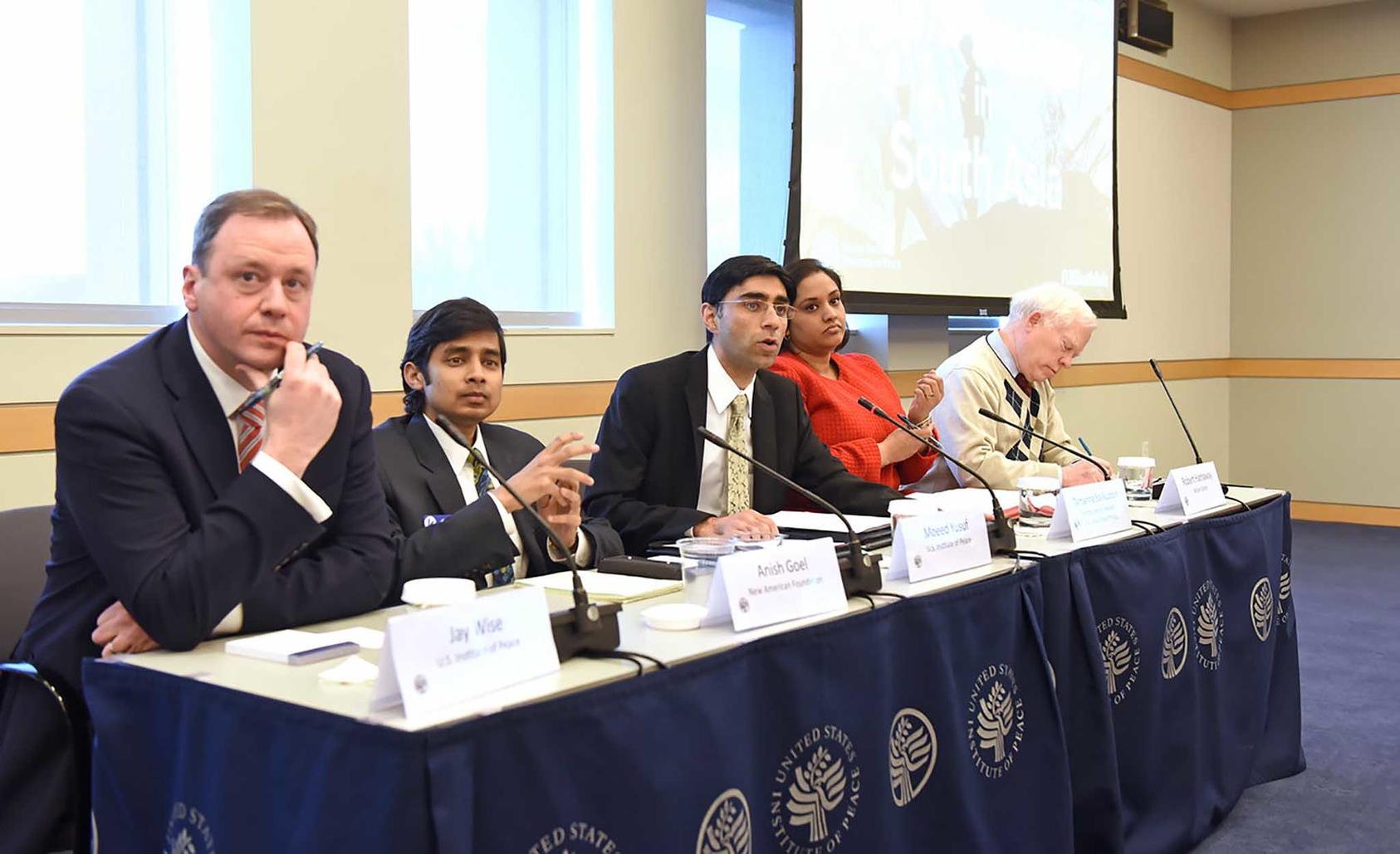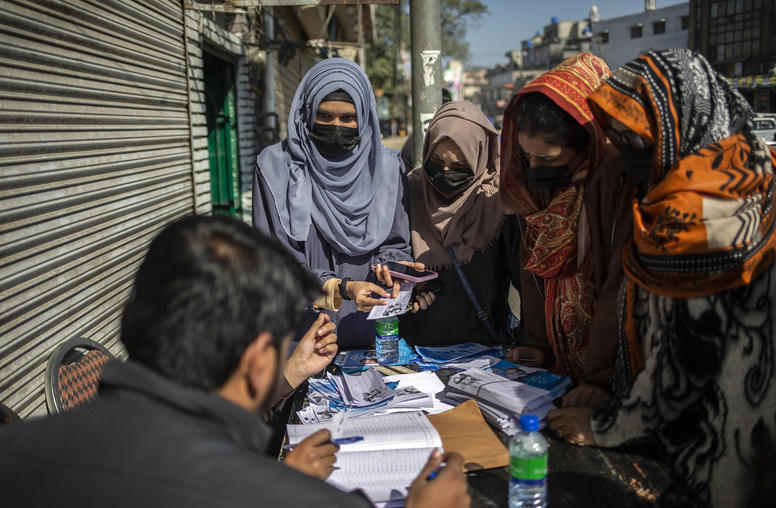U.S. Leverage in South Asia: Enough to Meet Policy Goals?
Area Experts Say U.S. Needs Realistic View of Limits on Regional Influence
As the U.S. seeks to advance its interests in South Asia 17 years into the Afghanistan war, a basic policy question unavoidably presents itself: How much leverage does America really have in the region?
The answer, according to discussion of area experts at the U.S. Institute of Peace last week, is both more and less than U.S. policymakers tend to think.

Since President Donald Trump laid out a new South Asia strategy in August, the U.S. has sought increased support from the region’s actors. It has curtailed aid and imposed penalties on Pakistan over terrorist sanctuaries, committed additional U.S. advisory troops to shore up Afghanistan’s security services, and called on India to boost investment in Afghanistan and become a more active regional partner. So far, the Taliban have ruled out talks with the Afghan government, Pakistani officials have remained non-committal toward administration demands, and the long-term alignment of U.S. and Indian interests in Afghanistan remains uncertain.
While U.S. leverage is limited by dynamics specific to each country, the leading cause of its constraint is essentially a lack of understanding, said Yusuf Moeed, a vice president of USIP’s Asia Center and moderator of the panel.
“Our policymakers around the world find it very hard to put themselves in their opposite number’s shoes,” Moeed said. “Oftentimes, I would argue, we wouldn’t do what we are asking other countries to do.” For the most part, the governments that the U.S. seeks to pressure won’t do it either, the panelists said.
The nature of leverage can range across a spectrum of carrots and sticks and ultimately should result in parties doing what they would not do otherwise, the panelists agreed. But where the pressure points are—if they, in fact, exist—and how they can be accessed is far less obvious.
Afghanistan’s Open-Ended Fight
The U.S. has the greatest leverage to steer events in Afghanistan even if officials fail to use it effectively, said Tamanna Salikuddin, who recently left the State Department after almost four years as a senior advisor to the special representative for Afghanistan and Pakistan.
Salikuddin said it’s true that the current administration has increased U.S. leverage in Afghanistan by committing to an open-ended fight against the Taliban, adding military trainers and boosting air support for Afghan forces. However, she asked, to what end? The war remains essentially a stalemate, with a resilient, rural insurgency making territorial gains while the government retains a firm hold on population centers, despite facing persistent terror attacks.
“What’s interesting in this context is that the words ‘political settlement’ or ‘reconciliation’ have become accepted by all sides,” Salikuddin said. “No one is saying they are going to win militarily. The real challenge is getting to the table: The Taliban says it will talk once foreign forces are out. The Afghan government says it will talk once there’s a ceasefire. We all know these preconditions are unlikely to be met.”
While the two direct parties to the conflict talk past each other, the U.S. has leverage that can jumpstart a peace process, so long as it does not view military power as the only source of its influence, Salikuddin said.
“The Taliban has about 80,000 fighters,” she noted. “We will not be able to kill our way out of this.”
Taliban Demands
The U.S. controls the conversation on the Taliban’s key demands, Salikuddin said: the removal of foreign forces and international acceptance of its legitimacy.
If the United States, as the strongest party to the conflict, can commit to at least discussing a timeline for conditions that would allow withdrawal, “it would go a long way toward bringing the Taliban to the table,” she said.
Regarding international legitimacy, the U.S. can make clear that the Taliban’s only route to recognition as a legitimate part of Afghan political life is joining the peace process. Such legitimacy can be held out as an opening for talks about lifting sanctions and inclusion in international peace efforts.
Asked by Moeed why no one in the region seems to believe the U.S. is serious about the peace process, Salikuddin compared the resources employed for military leverage with those applied to encouraging peace—and noted that the disparity makes an ample case for skepticism on the part of other regional governments.
Pakistan’s Power to Resist
U.S. leverage over Pakistan is far weaker as Pakistan holds a host of cards to resist U.S. pressure, said Robert Hathaway, the former director of the Asia Program at the Woodrow Wilson International Center for Scholars. Hathaway is the author of The Leverage Paradox: Pakistan and the United States, a book that examines why smaller, weaker countries so often succeed in defying larger and stronger ones.
Pakistan considers the Afghan Taliban a hedge against Indian influence in its western neighbor and in the present circumstances it won’t abandon what it views as a critical national security interest, Hathaway said.
Trump, however, has left no doubt that he believes in the leverage that American might confers, Hathaway said, including its capacity to force an end to Pakistan’s “duplicitous policy of providing succor to our enemies.” The suspension of security assistance [this year] was such an effort, he said.
While it’s too early to draw a conclusion, American officials unsurprisingly have seen little effect, Hathaway said. Pakistan’s behavior wasn’t changed by previous suspensions of aid, which in the context of Chinese investment and other sources of security assistance is increasingly modest. Had the president been familiar with Pakistani relations, he would have understood that the least persuasive route to affecting Pakistani leaders’ conduct is to publicly call them “knaves and liars” as he did in a January 1 tweet, Hathaway said, and grasped that smaller nations have leverage of their own. In the case of Pakistan, that includes American supplies for the U.S. and Afghan military moving through the country and the U.S. interest keeping Pakistan stable to safeguard its nuclear assets.
Terrorist Financing
In short, he said, “The United States has the power to punish, though not necessarily to compel.” That said, “it is better to be strong than to be weak,” Hathaway added. “Power can produce leverage and leverage can work.”
A recent example is action Pakistan took to combat terrorist financing ahead of a February meeting of the multilateral Financial Action Task Force—a set of measures it had previously refused to consider. The moves stemmed from “the threat of being singled out and publicly embarrassed for providing assistance to terrorists,” Hathaway said.
But the Task Force threat to put Pakistan back on the terrorism watch list made another critical point about leverage, Hathaway said: It occurred only after Washington succeeded getting Saudi Arabia and China to drop their earlier opposition.
“U.S. power is almost always magnified as part of a coalition, and especially when the members of that coalition are states that have been traditionally inclined to support the target country,” he said.
Indian Independence
The concept of leverage getting another country to do what it wouldn’t do otherwise, and with respect to India the United States has none, said Anish Goel, who oversaw South Asia on the National Security Council under President Barack Obama.
India is not dependent on the U.S. in any way and thinks of itself as having equal status, Goel said. Discussion with India must involve traditional, basic diplomacy that persuades the Indians their interests align with ours, said Goel, now a senior fellow at New America. “The good news in Afghanistan is they are now starting to align,” he said. Both countries want a stable, secure Afghanistan that is not a haven for terrorists and is not unduly influenced by its neighbors.
India is ready to meet Trump’s call for more help in Afghanistan with training the civilian government, economic assistance and in-kind contributions of resources. More broadly, however, the United States is asking India’s assistance in a range of matters including joint patrols in the Pacific Ocean, security in the South China Sea, climate change, trade negotiations and its relations with Pakistan. The United States has so far failed to set priorities, he said.
“We need to be careful that we don’t ask for so many things from the Indians that the Indians then have leverage over the United States,” Goel said.



